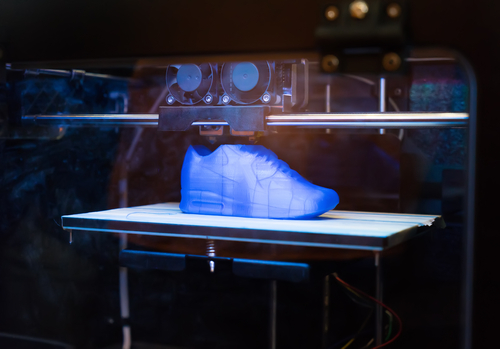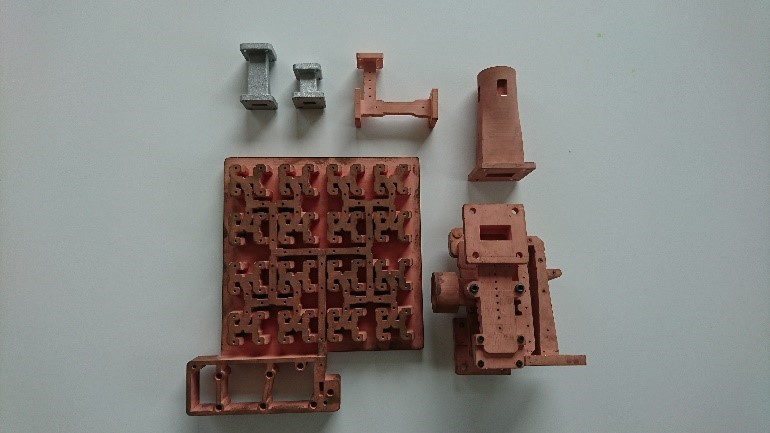Additive Manufacturing – making the impossible possible with 3D printing
Additive Manufacturing (AM) can be considered one of the most disruptive emerging technologies, its radical approach being one of the driving forces of the ‘fourth industrial revolution’. An Innovative aerospace supplier, SWISSto12, has developed under ESA’s ARTES Advanced Technology programme a patented technology based on AM to produce key satellite components – opening a new world of solutions for radio frequency applications.

Additive Manufacturing, also known as 3D printing, has recently become far more widespread and is rapidly showing its potential. Well-publicised examples show sculpted forms and figurines, startlingly-coloured platform polymer shoes or sneakers and miniature spun-nylon filigree-effect Eiffel towers. You can even 3D-print your smartphone cover at home in six easy steps. AM uses a digital file and manufactures the object layer by layer. This process is the opposite of traditional ‘subtractive’ manufacturing where the bulk material is removed, by chipping, melting, machining etc. to reveal the object or mould.
Aside from the more novel ‘plastic fantastic’ creations, AM has the potential to realise previously impossible designs utilising complex materials – allowing for ground-breaking leaps not just in the physical application of machined components but also the overall design and integration process.
ESA supported SWISSto12 in testing the suitability of using AM to 3D print RF User Terminal front-ends for communications-on-the-move applications whose markets require low to medium quantities (1 to 10 000 units) produced at reasonable costs – so that the final communication services can be offered at realistic market prices.
 For these quantities, the price of the user terminal itself has a significant impact on the total price of the service. Yet they are not sufficient to achieve economies of scale with traditional manufacturing technologies such as injection moulding or automated machining.
For these quantities, the price of the user terminal itself has a significant impact on the total price of the service. Yet they are not sufficient to achieve economies of scale with traditional manufacturing technologies such as injection moulding or automated machining.
The biggest advantage of using AM, however, is its inherent design and manufacturing flexibility, which is simply not possible using traditional means. By using AM, design engineers can achieve lighter, more compact, and higher performing RF components.
During the ESA-supported work, three different components taken from commercial terminals were successfully fabricated, including a diplexer, OMT (orthomode transducer) and an antenna array – with associated feed components. These components were made from Polymer materials and created using stereolithography (laser-based 3D printing). A coating was applied using a proprietary electroless copper plating procedure by SWISSto12. This new process allows the application of metallic plating (e.g. silver on copper) which is essential for good RF performance.
David Seguin, Technical Officer at ESA says: “An important feature of the components fabricated in this activity is the significant mass reduction, up to five times compared to the respective conventional components. Using AM, more advanced designs can be achieved that cannot be manufactured using traditional machining techniques which results in improved RF performance.”
“It is recognised that any reduction in mass and volume is crucial for space applications but is also very important for ground based equipment. The RF components which form the antenna feed chain must also be incorporated into the mechanical design as part of the weight balance and mechanical support of the system. The reduced mass and volume make for a more efficient and realisable simultaneous RF and mechanical design for ground based equipment. This is especially relevant for mobile applications”.

Dr Alexandre Dimitriades, RF Project Manager at SWISSto12 says: “We looked at some of the most complicated (RF) components and have proved that this technology is very promising, not least the possibility of replacing complicated assemblies of multiple parts with a single monolithic component, but also in the improved RF performance, due to the possibility to implement advanced designs that cannot be manufactured with conventional methods.”
“The actual performances reached after the last iteration seemed completely impossible at the beginning of this activity, given the complexity of the structures under study,” he says. “However, the technological advances in the domain of AM in general and the level of maturity reached by SWISSto12 over the last couple of years have made such performances possible.”


